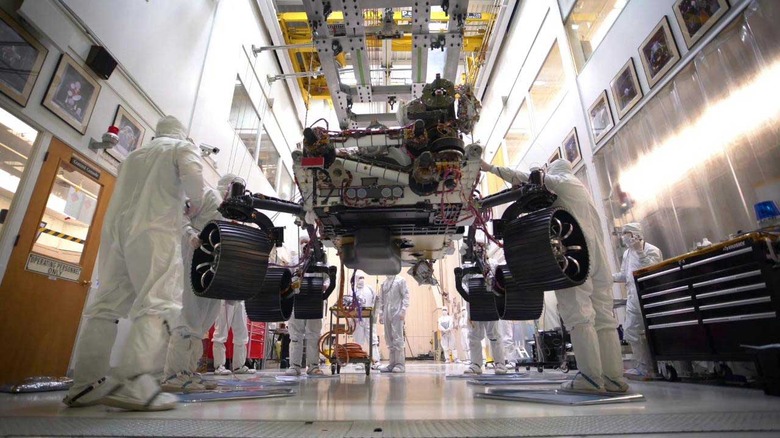Watch NASA Put The Newly-Assembled Mars 2020 Rover Into Vacuum Testing
NASA's 2020 Rover for the Mission to Mars may be standing on its own six wheels these days, but that doesn't mean it's quite ready to blast off to the red planet. Having celebrated the milestone of being fully-assembled last month, the 2020 Rover has now headed into a Mars Simulation Chamber to see how it might handle conditions there.
NASA shared a time-lapse video of the process of moving the rover from its high bay in the Spacecraft Simulator Building, to the large vacuum chamber where it underwent a whole array of tests. While that may not sound like much of a journey compared to the roughly 40 million miles between Earth and Mars, it's actually a fairly complex process.
"Whenever you move the rover, it is a big deal," Chris Chatellier, one of the Mars 2020 engineers at NASA's Jet Propulsion Laboratory in Pasadena, California, explains. "There is a technician on every corner, and other engineers and safety inspectors are monitoring and assisting every step of the way. Every move is choreographed, briefed and rehearsed."
As the name suggests, the large vacuum chamber is a huge room that can be pumped free of air, simulating the sort of conditions that the rover will face on Mars. It's not just vacuum conditions, however, that the rover will need to handle. The surface temperature of Mars is -81 degrees Fahrenheit on average, with that can range from -243 degrees Fahrenheit at the poles, to 68 degrees Fahrenheit at its warmest.
It's a tough challenge, but it's not the most difficult that NASA has faced. The James Webb Space Telescope, for example, went through even more arduous conditions during its vacuum testing, as engineers assessed its ability to handle the extreme cold of deep space. Chamber A in the Space Environment Simulation Laboratory at NASA's Johnson Space Center in Houston, Texas was upgraded with new cryogenic systems that allowed it to get as cold as -440 degrees Fahrenheit. That's just 11 degrees above absolute zero.

In contrast, Mars seems like a relative walk in the park – albeit one at great distance from JPL and any hope of rectifying mechanical issues. After being tested in the vacuum chamber, the rover was carefully wheeled back into the Spacecraft Assembly Facility for even more tests, that time focusing on radio emissions.
If all goes to plan, the Mars 2020 mission is expected to launch in July 2020. It'll take as long as seven months to make the trip from Earth to the red planet, scheduled to land at Jezero Crater on February 18, 2021.
